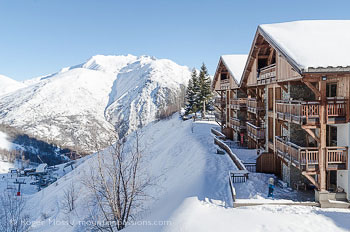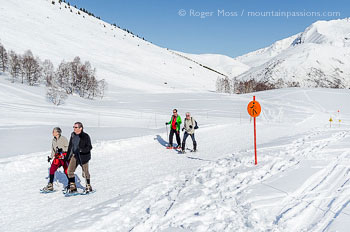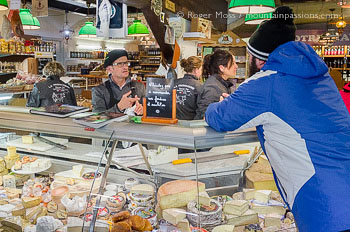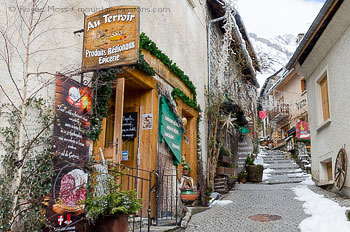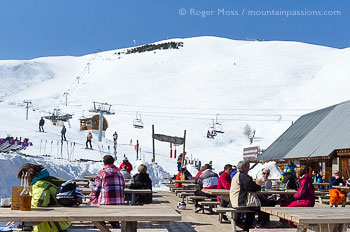Insight: Les 2 Alpes
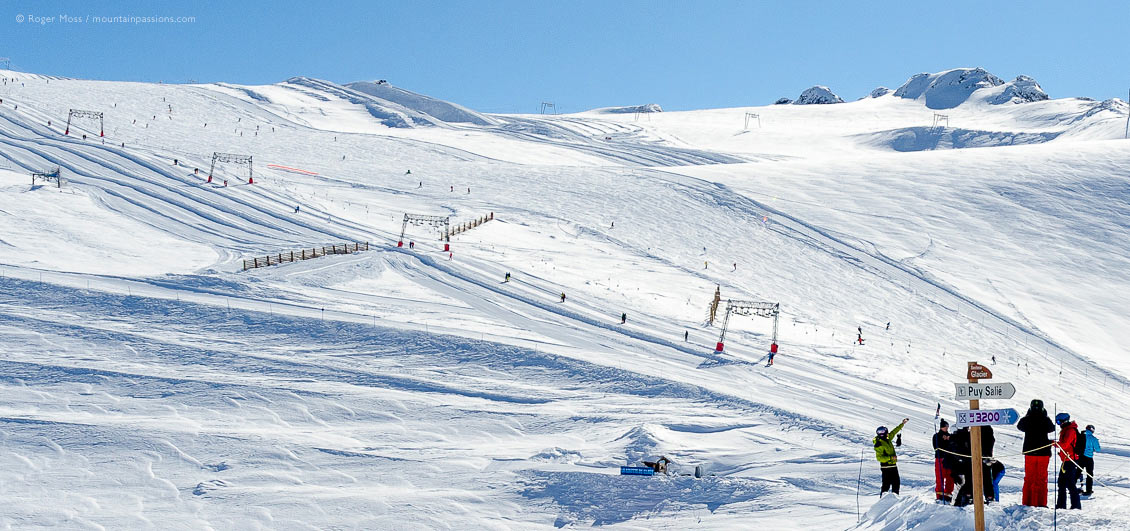
Insight: Les 2 Alpes
A lot has happened since we first got to know Les Deux Alpes (also known as Les 2 Alpes or L2A), and it all seems to have been for the good. What once looked like a resort focused predominantly on young skiers and snowboarders, and with endless fast-food outlets, has raised its game considerably, and now has a quality air and consequently a much broader appeal. Progress indeed.
The piste network and lift system have also received big investments, not least the provision of a blue-graded run enabling intermediates to ski virtually from top to bottom, with the previous final steep section bypassed. That’s welcome news for intermediates in a resort whose ski terrain is actually easier the higher you go.
As an unexpected bonus, our base, a self-catering apartment at Le Val Ecrin, near the entry to Les 2 Alpes 1800, offers views across to the famous Sarenne piste in l’Alpe d’Huez, to which Les 2 Alpes will be lift-linked in a few years time. That’s going to be some lift, and will create one of the world’s biggest ski areas. For now, though, we’re happy to be here, particularly when snow starts to fall shortly after nightfall and continues for most of the night.
The following morning we walk 100m or so to join the lower end of the green-graded Petite Aiguille return piste, snap into our skis and take a quick run down to two nearby lifts. The Petite Aiguille chairlift heads up to the connector run above Les 2 Alpes 1800, but we take Cotes 4-seater, which carries us across to the Vallée Blanche sector on the opposite side of the valley.
At the top there’s the option of skiing back to the base of the lift on the Cotes piste or – our option – of dropping down on a slightly steeper blue to pick up the Vallée Blanche 4-seater chair for a haul up to around 2300m. When we ski off we pause to look around, since much of the main ski area across the valley is now laid before us like a giant 3D piste map.
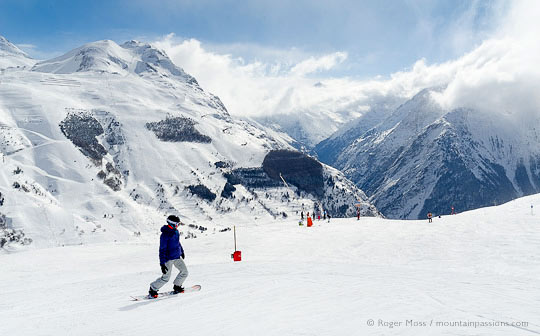
With few draglifts, a big snowpark and other fun zones, snowboarders of all ages love coming to Les 2 Alpes.
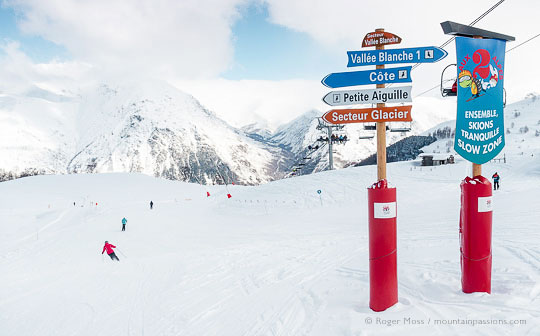
The mid-mountain slow zone on blue pistes is especially good for learners.
Skiing Les 2 Alpes’ own Vallée Blanche
Beside us an unnamed blue appears on the piste map to head along a crest, arc right and access a choice of lifts. It soon feels remote and unskied, though, and drops away out of sight, so we turn off onto a steep red which fires us down to the Vallée Blanche chairlift, where we’d have ended up anyway.
Although quite limited, the Vallée Blanche includes a couple of steep reds below the Pied Moutet (2339m) with dramatic views across a deep valley, at the foot of which Venosc is currently hidden from view. There’s also a short but steep section waiting at the foot of a blue-graded drop to Super Venosc, the sector’s last chairlift.
Once down we head straight back up again and pack in a few more quick runs before stopping for lunch back at the apartment. We’re at the opposite end of the valley, but heading back is surprisingly quick. All it takes is a cruise down the blue-graded Vallée Blanche piste, which feeds onto Cotes for the run over to just below our accommodation. From here the Petite Aiguille chair drops us neatly beside the green-graded Demoiselles piste for a quick glide down to the Petite Aiguille piste. Now one final cruise brings us back to our starting point. Simple – and more fun than a shuttle bus.
Up & Away: Les 2 Alpes’ main ski area
In the days to come heading out to explore the other terrain from Les 2 Alpes 1800 follows a simple routine. Unless we see a shuttle bus approaching, we ski down to the Petite Aiguille chair, ride up to the Demoiselles piste then let our skis run all the way to the front de neige. The only exception is on mornings when crowds of skiers are homing in on the main gondola lifts, in which case we leave Demoiselles to ride the Village 1800 and Crêtes chairs up to other onward lifts.
Mostly, though, the logical departure points are via the slightly antique Oeufs Blancs gondola, the muscular Jandri Express 20-seat DMC or the Diable 8-seater high-speed chairlift. That adds up to a lot of skier capacity, but it still takes awhile to ride all the way up to the terrain on the glacier – almost 7km (with a climb of 1600m) in the case of the Jandri Express.
Each route offers a very different riding experience, and is suited to different areas. Mid-mountain highlights for us include the exhilarating steep drops among dramatic scenery from the the top of the Super Diable chairlift (2776m), plus the more relaxing “Ski Tranquille / Slow Zone” runs in the La Fée area.
.
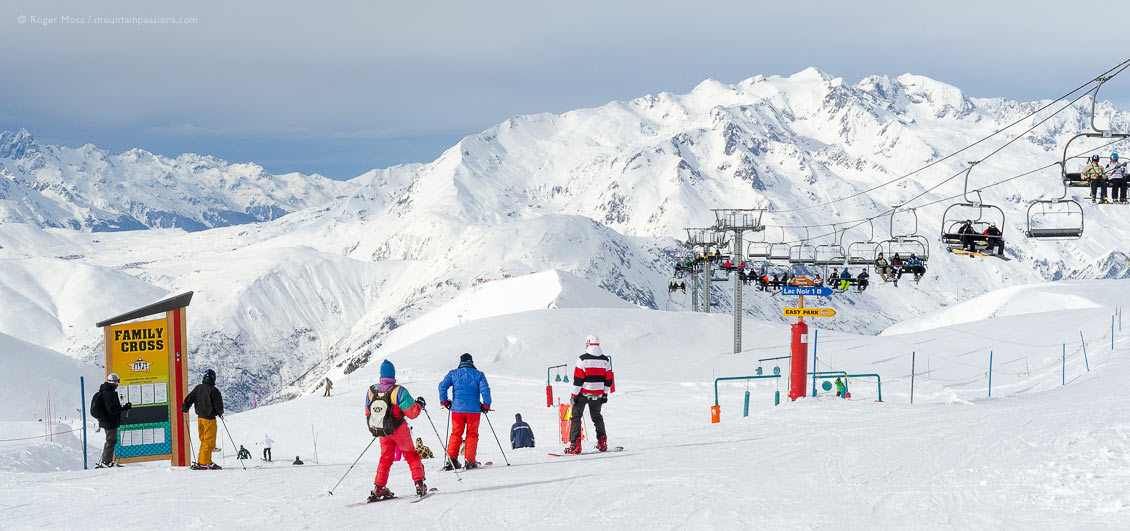
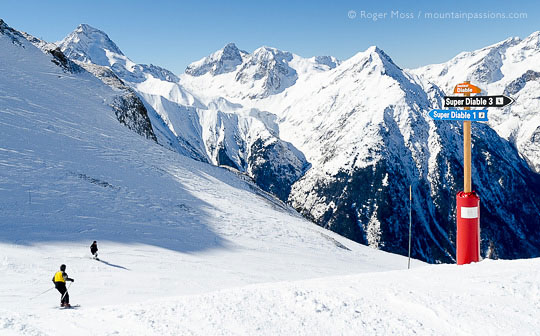
Challenges come in the form of a couple of black graded runs and plenty of off-piste.
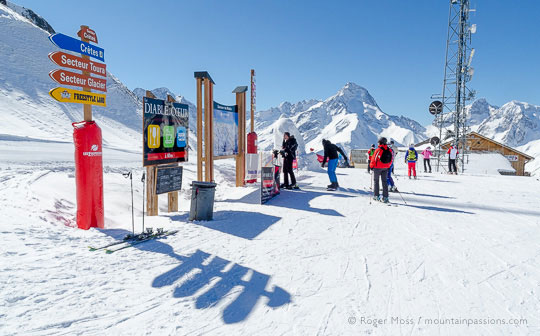
Plenty of information to help direct skiers between different sectors.
From the steeps to Les 2 Alpes’ Slow-Go Area
With so many options for fun-focused experienced skiers and boarders, a sector dedicated exclusively to taking things (very) easy seems like an inspired concept. La Fée is easily accessible to timid or early intermediate skiers via the Jandi Express 1 lift or the Oeufs Blancs gondola + Jandri 2 cable car, but its pleasing away-from-it-all sense of remoteness is also hard for the rest of us to resist. Add the fact that it’s located just below the relatively confined area below the Glacier sector and you can see the appeal of a detour into more tranquil, natural-feeling surroundings.
Not that it’s without a few challenges. In addition to the blue-graded cruises there’s also a couple of reds, a black and an unpisted run dropping down to the Thuit chairlift.
Meanwhile, way up on the glacier…
Until it created the world’s longest piste (and greatest vertical drop), Les 2 Alpes’ killer feature was its glacier, which enables it to offer summer skiing. In winter the snow quality is exceptional, and attracts waves of skiers to the fastest route up the mountain, namely the Jandi Express 1 & 11 DMC lifts. Joining them well before mid-morning means we have to queue, but it’s worth it for what is by any standards an epic haul (6.7km) to the foot of the glacier 3183m.
When we finally step out we pass on a Tee-bar haul in favour of the Dôme Express funicular, which passes under the glacier to drop us at 3384m. But there’s more – the Lauze draglift offers a final tug up to 3525m, beyond which you’re in Snowcat territory for the transfer to La Grave’s steep, unpisted terrain on its own glacier (La Meije).
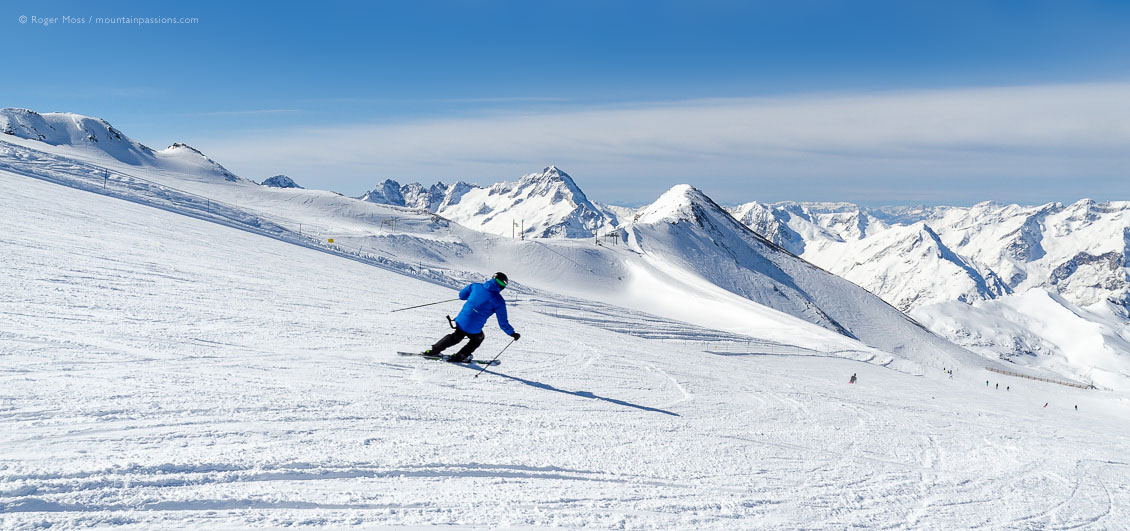
On top of the world
Is it worth it? The tempting answer is another question: Why wouldn’t you? The sensational views alone more than repay the effort, and you really can see for many miles in every direction. It’s hard to take in the scale of things, but an orientation panel identifies the main peaks to help you make sense of just where your’re standing.
In winter at least, most people are more focused on the skiing, which apart from a couple of reds down to the Signal draglift, is on wide, shallow-pitched blues bounded by Tee-bar lifts or banks of snow nudged into neat lines by the piste groomers to build up stocks for summer.
But it’s not about challenges; what puts a big, childlike smile on your face is the sensation of floating near-effortlessly on light, powdery snow – and pistes this wide give plenty of room to lean your skis’ edges into the carve for which they were carefully designed..
All the way down: Les 2 Alpes’ 2300m vertical drop
Yes, it’s well worth skiing on the glacier – and of course when you reach the bottom of the glacier there’s no need to feel you have to stop there. Considering that it cost some 10 million euros to create, you might like to ski the Resort Return piste, for a blue-graded run all the way down to the village which adds up to around 2000m of vertical drop.
That’s quite something for ordinary leisure skiers to tell their friends, while if they’re comfortable on reds they can look out for Access Vallée Blanche signs and continue skiing down to Mont de Lans – taking the vertical up to an unparalleled 2300m. Being in a shady combe, it’s often icy down there, but we found no problem finding edge grip, and loved the natural setting below the tree-line.
As a bonus, the slow chair-ride back up gives plenty of time to take in the scenery, and wait for the amused reactions of skiers as they suddenly encounter the low-grip sections of the piste below.
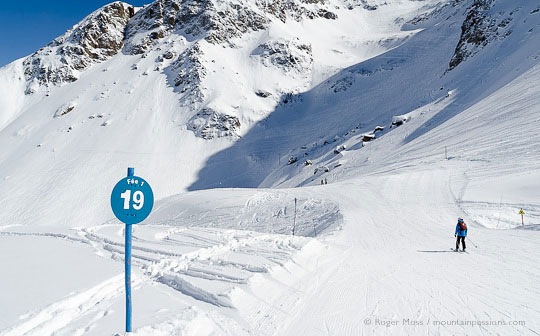
Take the quiet Fée pistes for wild mountain scenery.
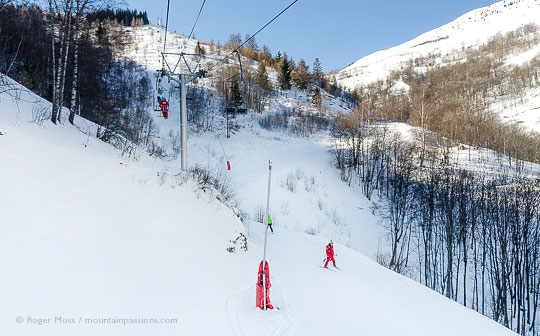
One of the lower wooded pistes seen from the chairlift.
Dropping in on Venosc
Les 2 Alpes’ dramatic location is only revealed when you take the gondola lift down to Venosc, in the Vallée du Vénéon, some 700m below. The gondola took over from a cable-car, which in turn replaced a cable which carried hay bales from the Alpine pastures down to the farms in the valley until tourism appeared and made life a lot less difficult for the villagers. Part of their story is recounted in a series of interpretation panels at various viewpoints around the village, which is well worth taking the time to discover.
The traditional architecture is well preserved and today the narrow streets in the village heart are home to craft boutiques, bars and restaurants. The walk up from the lift gives a sense of the remote setting of the valley, which became an important mountaineering centre during the early 20th Century.
Les 2 Alpes: Parting Thoughts
Les 2 Alpes has long been popular among leisure skiers and snowboarders, despite tough competition further north, not to mention in neighbouring l’Alpe d’Huez. The two rivals are finally destined to be linked by gondola lift, creating in a shared domain offering 474km of pistes – a figure second only to the 3 Vallées.
The 60 million euro budget for the link (due for completion in 2021) is nothing, however, compared to the cost of upgrading each ski area, which will bring the total bill to a staggering 350 million. For now, though, we can say that we’re already impressed by the many improvements which have already enabled Les 2 Alpes to raise its game significantly. There’s great skiing, most of it designed for intermediates, while the village looks and feels revitalised since we last saw it. We’re already looking forward to returning. 
Feature by Roger Moss, © 2025
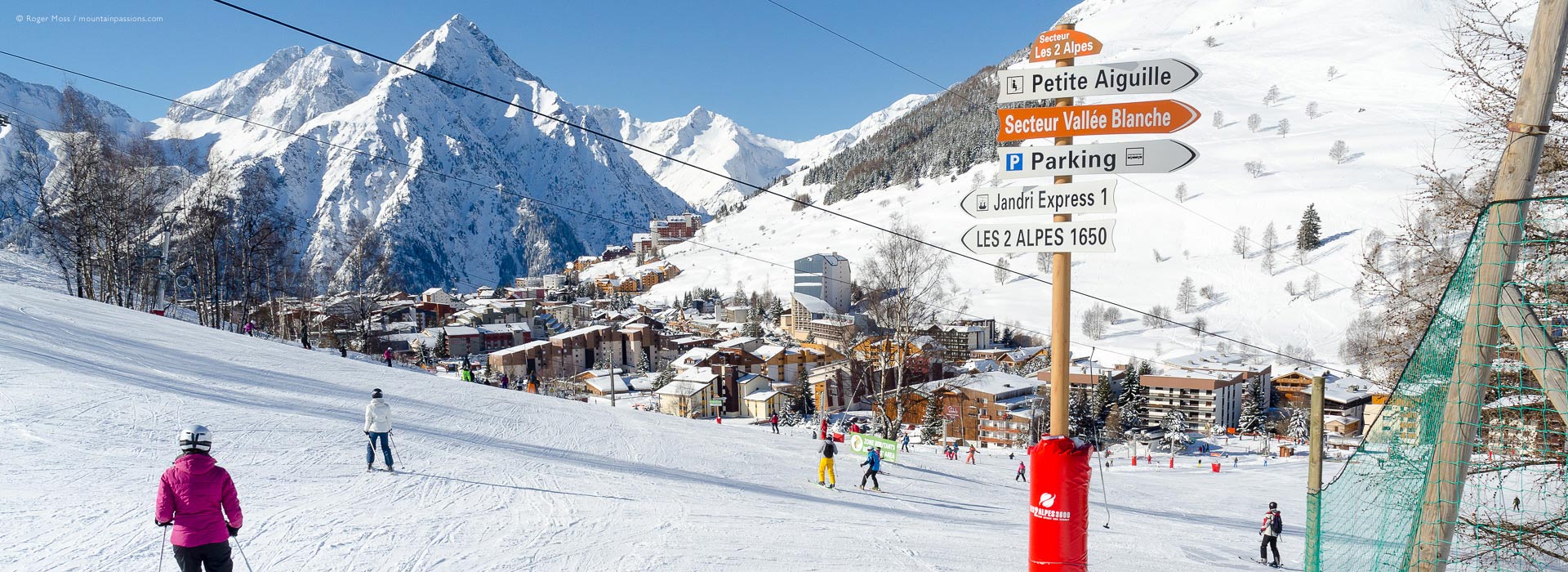
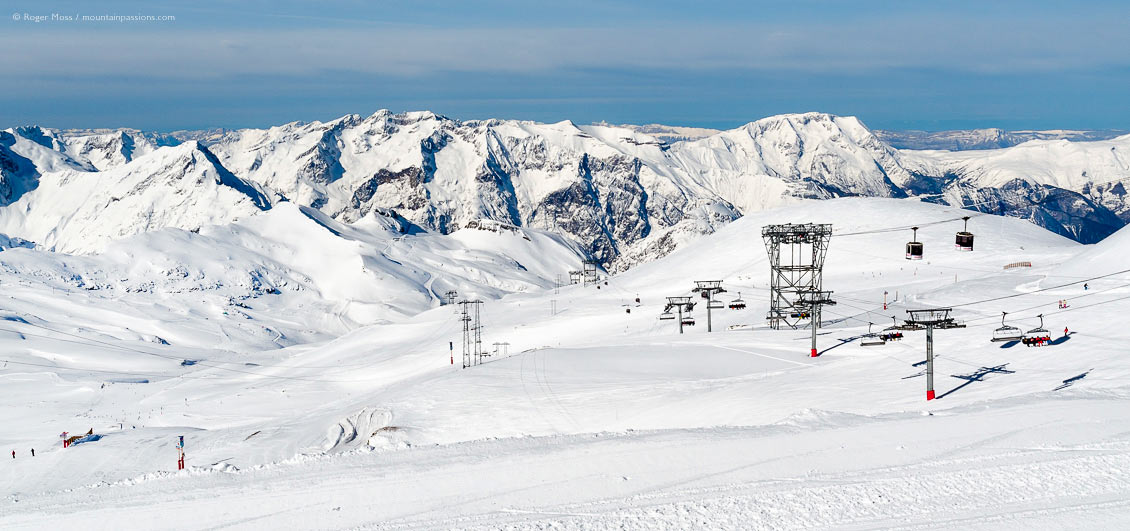

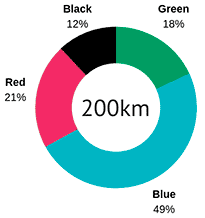
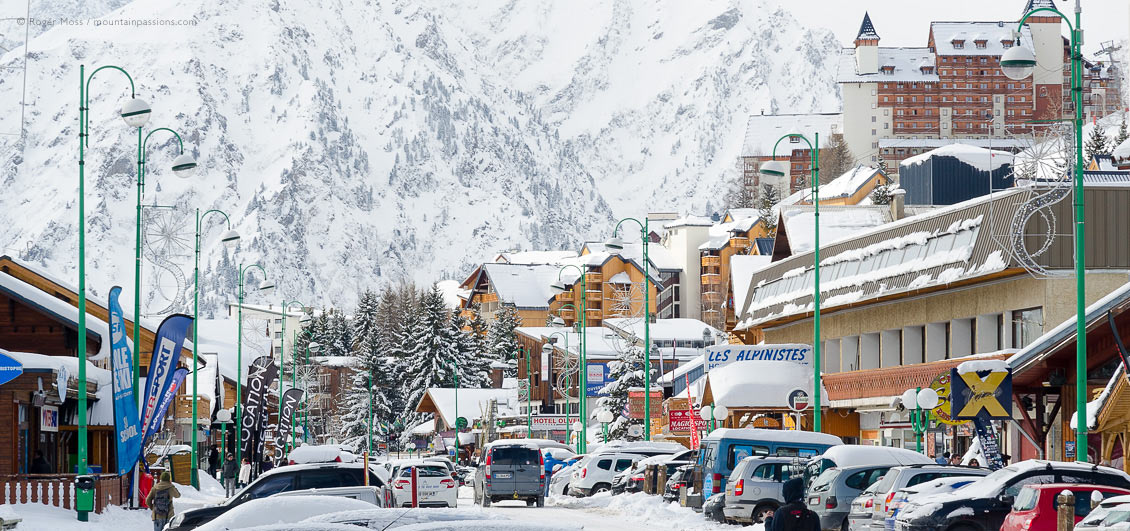

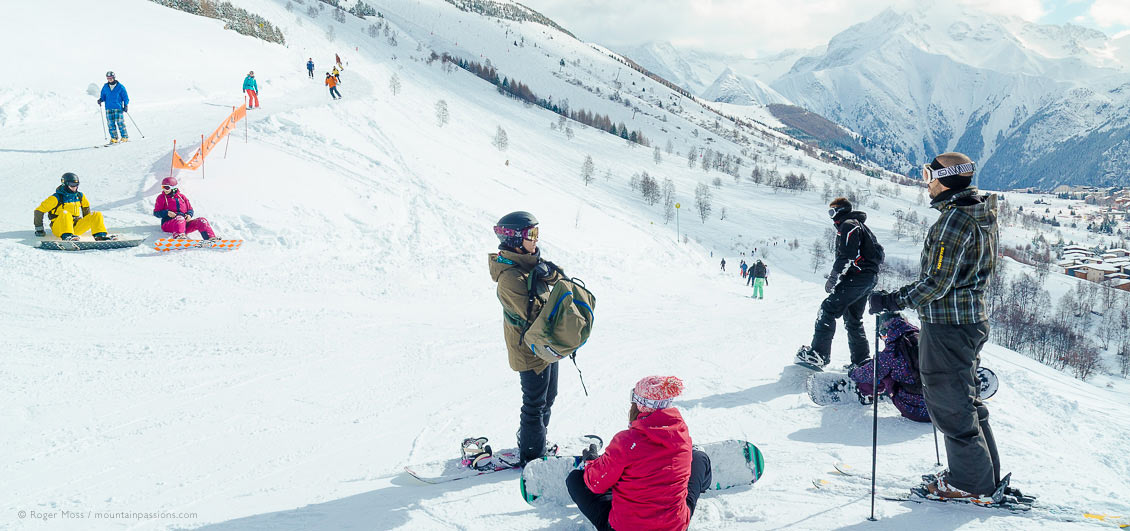

 Goleon - Le Val Ecrin
Goleon - Le Val Ecrin 